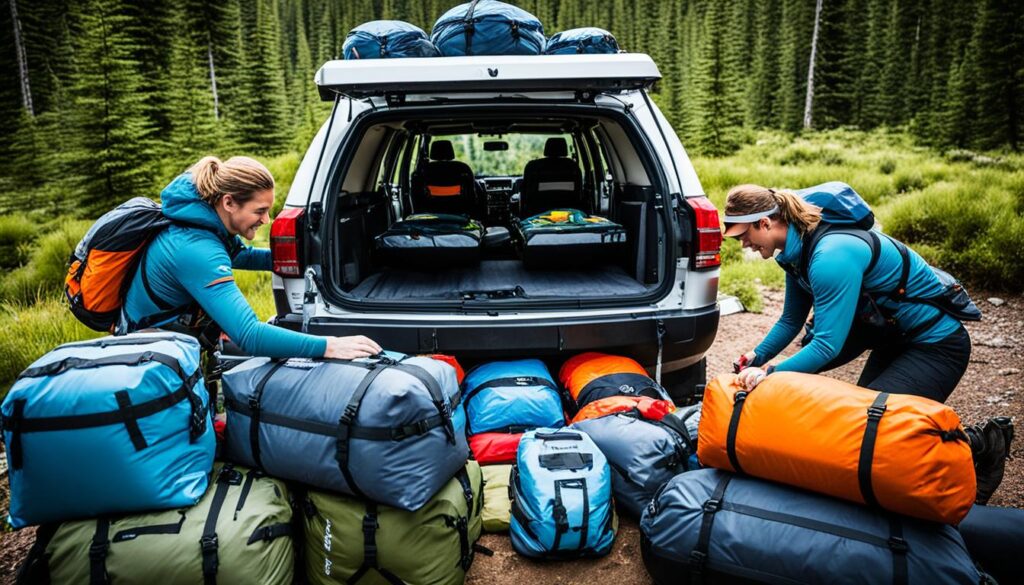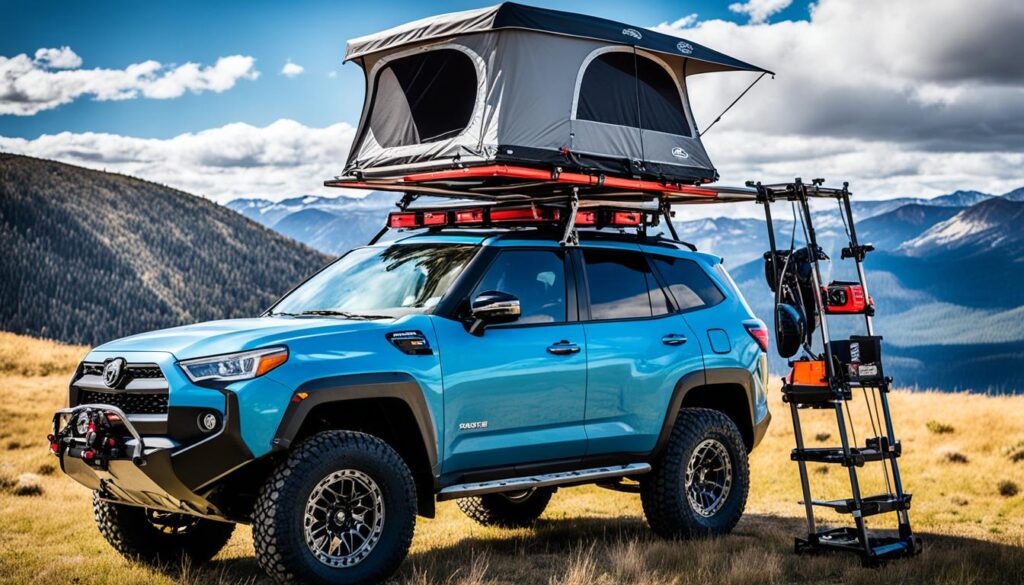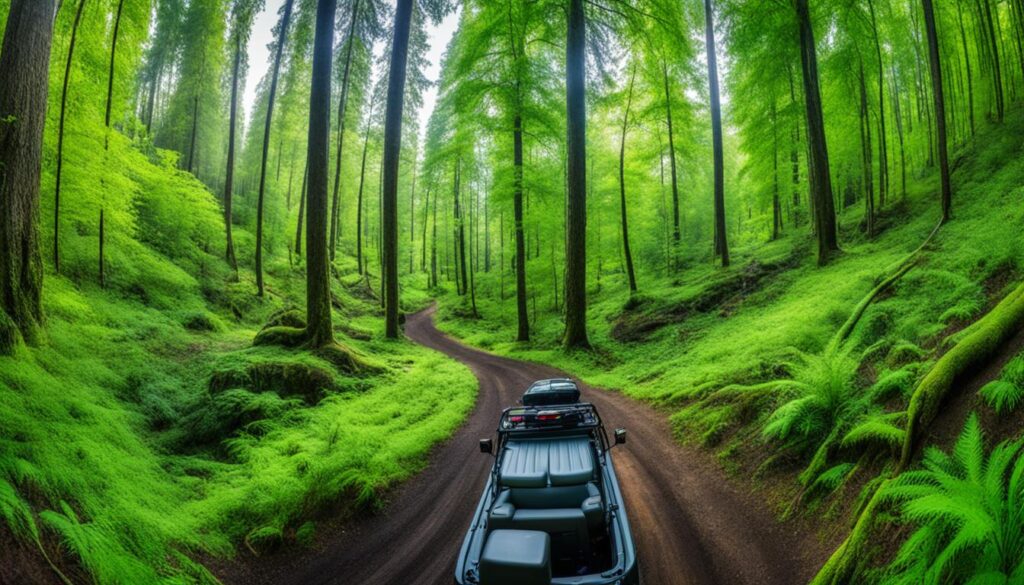Are you ready to embark on an off-road adventure and explore nature’s hidden gems? Imagine driving through breathtaking landscapes, camping in remote locations, and discovering overlanding trails that take you off the beaten path. But the question is, how do you find these elusive trails? How do you navigate through the vast wilderness to uncover the best overlanding routes and top destinations?
In this article, I will share valuable tips and resources on how to find overlanding trails for your next adventure. Whether you’re a seasoned overlander or a curious beginner, this information will help you uncover hidden off-road trails, embrace the thrill of off-the-grid camping, and navigate through the wilderness with confidence. Get ready to explore off-the-beaten-path trails and discover the beauty of remote overlanding destinations.
Key Takeaways:
- Overlanding is a thrilling way to explore nature off the beaten path.
- Finding the right overlanding trails can be challenging.
- Utilize online resources, such as Trails Offroad and overland apps, to locate trails.
- Consult governmental websites and park rangers for reliable trail information.
- Proper preparation and understanding your vehicle are crucial for a successful overlanding experience.
Overlanding is not just a road trip; it is a vehicle-dependent journey where the primary goal is the journey itself. Unlike traditional camping, overlanding involves traveling long distances in remote areas, living in your vehicle, and surviving on limited resources. This unique experience allows you to truly connect with nature and explore uncharted territories. Understanding the essence of overlanding will help you appreciate the importance of finding the right trails for your adventure.
When comparing overlanding to road tripping, the key difference lies in the focus and mindset. Road trips often prioritize reaching a destination quickly, while overlanding is about immersing yourself in the journey, embracing the challenges, and forming a deeper connection with the natural world. It is a self-reliant adventure, where you become fully responsible for your well-being and resource management.
Being vehicle-dependent means that your vehicle is not just a mode of transportation, but your shelter, kitchen, and lifeline throughout the journey. Overlanding allows you to escape the crowded tourist destinations and embark on a self-sustained exploration of remote landscapes. It fosters a sense of independence and offers limitless opportunities for discovery.
Overlanding is about immersing yourself in the journey, embracing the challenges, and forming a deeper connection with the natural world.
When you venture into the world of overlanding, you enter a realm where adaptability and resourcefulness are paramount. Your ability to survive and thrive in various terrain and climates relies on your knowledge, skills, and the gear you carry. It is an adventure that pushes you to your limits and rewards you with unforgettable experiences.
At its core, overlanding is not just an outdoor activity; it is a lifestyle that encourages exploration and embraces the unknown. It allows you to break free from the constraints of everyday life, escape the mundane, and challenge yourself both mentally and physically. By undertaking this vehicle-dependent journey, you embark on a remarkable self-reliant adventure that unlocks the beauty and vastness of the natural world.
Overlanding vs. Road Tripping
| Overlanding | Road Tripping |
|---|---|
| Vehicle-dependent journey | Destination-focused trip |
| Living in your vehicle | Staying in hotels/motels |
| Long distances in remote areas | Shorter drives on established roads |
| Surviving on limited resources | Access to amenities along the way |
| Immersive connection with nature | Less deep engagement with surroundings |
Ways to Find Overlanding Trails
Finding overlanding trails can be overwhelming, but there are several reliable resources you can use to simplify the process. Here are some effective methods to help you discover the perfect trails for your next overlanding adventure:
1. Using Google for Trail Search
Google is a powerful tool that can assist you in finding overlanding trails near your location. Simply input relevant keywords like “overlanding trails” or “off-road routes” along with your destination, and Google will provide you with a list of potential trails to explore. Take advantage of the suggested websites, maps, and user reviews that appear in the search results to gather more information about each trail.
2. Free Websites for Trail Information
There are numerous websites available that offer free information about overlanding trails. These platforms are created by fellow overlanders who share their experiences and knowledge. Websites like AllTrails, Trailsoffroad, and Overlanding USA provide valuable insights, including trail difficulty, points of interest, and user reviews. Browse through these websites to find trails that align with your preferences and skill level.
3. Paid Websites for Trail Information
If you prefer more comprehensive and accurate trail information, consider subscribing to paid websites. Platforms like OnX Offroad and Gaia GPS offer detailed trail descriptions, GPS tracks, and even offline maps for easy navigation. These paid services often provide additional features such as real-time weather updates, elevation profiles, and suggested campsites. Investing in a paid subscription can enhance your overlanding experience and ensure you have all the necessary information at your fingertips.
4. Forums for Trail Recommendations
Overlanding forums are valuable resources for connecting with experienced overlanders and obtaining trail recommendations. Websites like Expedition Portal and Overland Bound have active communities where members share their favorite trails, give advice, and answer questions. Join these forums, ask for recommendations based on your location or desired difficulty level, and benefit from the firsthand experiences of fellow overlanders.
5. Governmental Websites for Trail Details
Governmental websites, such as the Bureau of Land Management (BLM) and the U.S. Department of Agriculture Forest Service, provide reliable information on specific camping locations and trails. These websites offer comprehensive details about trail conditions, required permits, camping regulations, and any seasonal closures. It is important to consult these websites to ensure you have up-to-date and accurate information about your chosen trails.
6. Overland Apps for Trail Planning
Overland apps are specifically designed for overlanders and offer a wealth of trail information and planning tools. Apps like Gaia GPS and iOverlander provide detailed maps, user-generated trail reviews, campsite recommendations, and even allow you to plan and track your journeys. These apps often have offline capabilities, ensuring trail navigation even in areas with limited or no signal.
7. Paper Maps for Trail Navigation
While digital resources are convenient, paper maps are essential backups for trail navigation. National Geographic, Benchmark Atlas, and other brands offer printed maps specifically designed for off-road adventures. Paper maps can help you visualize the area, plan alternative routes, and navigate when technology fails. Remember to carry a compass as well to complement your map reading skills.
8. Asking Park Rangers for Trail Advice
Park rangers are invaluable sources of local knowledge and can provide expert advice on overlanding trails. When visiting national parks, national forests, or other protected areas, be sure to stop by the ranger station and ask for recommendations. Park rangers can offer insights into trail conditions, recent wildlife sightings, and any specific precautions you should take.
By utilizing a combination of these methods, you can effectively find overlanding trails that suit your preferences and skill level. Whether you prefer online research, community engagement, or traditional resources, there is a wealth of information available to help you embark on your next memorable overlanding adventure.
Essential Tips for Overlanding Preparation
Before embarking on an overlanding trip, it is crucial to ensure that your vehicle is reliable and well-equipped for the journey. Regular maintenance and necessary repairs should be conducted to avoid breakdowns in remote areas. Safety equipment such as first aid kits, emergency communication devices, and vehicle recovery kits are essential for handling potential risks. Understanding your vehicle’s limits and capabilities is crucial for a successful overlanding experience. When choosing an ideal overlanding vehicle, factors such as four-wheel drive capability, quality tires, access to spare parts, and overall reliability should be considered.
Properly preparing for your overlanding adventure sets the foundation for a safe and enjoyable journey into the wild. Here are some essential tips to consider:
- Vehicle Reliability: Regular maintenance and necessary repairs are crucial to ensure your vehicle is in optimal condition. This includes checking the engine, brakes, suspension, and electrical systems.
- Importance of Safety Equipment: Invest in high-quality safety equipment, including a comprehensive first aid kit, emergency communication devices such as a satellite phone or a Garmin inReach Mini, and a vehicle recovery kit for potential off-road challenges.
- Understanding Vehicle Limits: Know the capabilities and limitations of your vehicle. Research its off-road capabilities, ground clearance, and towing capacity. Understanding how to operate features like four-wheel drive and low-range gearing is essential for navigating challenging terrain.
- Ideal Overlanding Vehicles: When selecting a vehicle for overlanding, consider factors like four-wheel drive capability, durability, and reliability. Popular options include trucks, SUVs, and capable off-road vehicles like the Toyota 4Runner, Jeep Wrangler, or Ford F-150.
To help you visualize the preparation process, here’s a breakdown of essential features and considerations for overlanding vehicles:
| Feature | Description |
|---|---|
| Four-Wheel Drive | Allows power to be delivered to all four wheels simultaneously, providing enhanced traction and off-road capabilities. |
| Tires | Durable all-terrain or mud-terrain tires with good tread depth for improved traction and durability on varied terrain. |
| Suspension | An upgraded suspension system with increased ground clearance and improved handling over rough terrain. |
| Storage Capacity | Ample cargo space or the ability to install roof racks, storage systems, or a bed rack to carry camping gear, food, water, and equipment. |
| Recovery Points | Front and rear recovery points to attach recovery straps or winches in case of vehicle recovery situations. |
These tips and considerations ensure that you’re well-prepared when venturing into remote areas on your overlanding journey. By understanding your vehicle’s capabilities, equipping it with the necessary safety equipment, and choosing an ideal overlanding vehicle, you’ll be ready to embrace the challenges and have a memorable experience. Remember, meticulous preparation leads to a successful overlanding adventure.

Must-Have Gear for Overlanding
Ensuring a safe and enjoyable overlanding trip requires having the right gear. The following essentials should be included in your overlanding arsenal:
1. First Aid Kit
An extensive first aid kit is a must-have for any outdoor activity, including overlanding. It should include bandages, antiseptic solutions, pain relievers, insect repellent, and other medical supplies to address potential injuries.
2. Emergency Communication Devices
When venturing into remote areas, having reliable communication devices is crucial. The Garmin inReach Mini is a popular choice among overlanders, providing a lifeline in case of emergencies and allowing you to stay connected with loved ones.
3. Vehicle Recovery Kit
Getting stuck in challenging terrain is a common occurrence during overlanding. A vehicle recovery kit equipped with essentials like tow straps, shackles, traction boards, and winches will help get your vehicle back on track.
4. Tools and Spare Parts
It’s essential to be prepared for small repairs while on the go. Carry basic tools like wrenches, socket sets, and pliers, along with spare parts like fuses, belts, and hoses. These items can make a significant difference in resolving minor issues and keeping your journey on track.
5. Water and Cooking Equipment
Access to clean water and proper cooking equipment is vital for sustenance during your overlanding trip. Pack ample water supply, and consider investing in water filtration systems to ensure a safe drinking source. Additionally, bring portable stoves, cookware, and utensils to easily prepare meals in the great outdoors.

| Essential Gear | Description |
|---|---|
| First Aid Kit | An extensive kit including bandages, antiseptic solutions, pain relievers, and insect repellent to address potential injuries. |
| Emergency Communication Devices | Devices like the Garmin inReach Mini provide a lifeline in emergencies and keep you connected even in remote areas. |
| Vehicle Recovery Kit | Equipped with tow straps, shackles, traction boards, and winches to recover your vehicle from challenging terrain. |
| Tools and Spare Parts | Basic tools like wrenches and pliers, along with spare parts like fuses and belts, for quick repairs on the go. |
| Water and Cooking Equipment | Adequate water supply, water filtration systems, and portable cooking equipment for sustenance during the trip. |
Tips for Planning and Navigation
Proper route planning is crucial for a successful overlanding trip. When embarking on an adventure off the beaten path, it’s essential to research and understand the routes and weather conditions you’ll encounter along the way. By utilizing online resources like iOverlander, Gaia GPS, and Recreation.gov, you can gain valuable insights into the terrain, camping regulations, and potential challenges that lie ahead.
Having a backup navigation option is essential, especially when venturing into remote areas with limited connectivity. While digital navigation tools are convenient, it’s crucial to carry a paper map as a reliable fallback. A paper map ensures that even if your electronic devices fail or lose signal, you’ll still be able to navigate your way through the wilderness.
The Leave No Trace principles should always be at the forefront of your mind when overlanding. Respecting and preserving the natural environment is paramount. Be mindful of where you set up camp, dispose of waste responsibly, avoid damaging vegetation, and minimize your impact on wildlife. By following these principles, you can help protect the wilderness for future generations of overlanders to enjoy.
Traveling with others
Embarking on an overlanding journey with others not only enhances camaraderie but also ensures safety. When traveling in a group, you can rely on each other for support, share responsibilities, and navigate challenging terrains more effectively. Additionally, experienced overlanders can offer valuable insights and tips based on their previous adventures.
| Benefits of traveling with others: |
|---|
| Enhanced safety and security |
| Shared responsibilities |
| Collective knowledge and experience |
| Support in challenging situations |
“Traveling with others not only enhances the overall experience but also provides added safety and support during the journey. Sharing responsibilities and benefiting from the collective knowledge and experience of your travel companions can make your overlanding trip even more memorable.”
Remember, proper planning, thorough research, backup navigation options, adherence to Leave No Trace principles, and traveling with others will contribute to a rewarding and safe overlanding experience.
Conclusion
Finding the right overlanding trails is the key to a memorable and safe adventure. Through the tips and resources mentioned in this article, you now have the tools to easily locate the best routes for your next overlanding trip. Thorough preparation and research are of utmost importance in ensuring a successful journey into the wild unknown.
By understanding your vehicle’s capabilities and limitations, you can make informed decisions when choosing a trail. Regular maintenance and equipping your vehicle with reliable gear are essential for a smooth overlanding experience. Remember to pack a comprehensive first aid kit, emergency communication devices, and vehicle recovery kits to handle any unforeseen challenges.
Utilize online resources, such as Google, free and paid websites, overland apps, and governmental websites, to gather comprehensive information about the trails. Plan your route, research weather conditions, and follow Leave No Trace principles to minimize your impact on the natural environment.
With thorough preparation and the right gear, you’re ready to embark on an unforgettable overlanding adventure. Strap in, explore the beauty of nature, and enjoy the freedom of the open road. Happy overlanding!
FAQ
How can I find overlanding trails for my next adventure?
There are several ways to find overlanding trails. You can use Google to search for trails near your location, explore free websites and forums for valuable information shared by other overlanders, or consider using paid websites for comprehensive trail descriptions. Governmental websites such as the Bureau of Land Management and the U.S. Department of Agriculture Forest Service also provide reliable information on specific camping locations. Overland apps like Gaia GPS and iOverlander are dedicated to offering overlanding information and trail planning. Alternatively, you can use paper maps or consult park rangers for trail advice.
What is overlanding and why does it matter?
Overlanding is a vehicle-dependent journey where the primary goal is the journey itself. It involves traveling long distances in remote areas, living in your vehicle, and relying on limited resources. Unlike traditional camping, overlanding allows you to truly connect with nature and explore uncharted territories. It matters because it offers a unique and immersive experience that goes beyond a simple road trip, allowing you to embrace self-reliance and explore off-the-beaten-path locations.
How should I prepare for an overlanding trip?
Before embarking on an overlanding trip, it is crucial to ensure that your vehicle is reliable and well-equipped. Regular maintenance and necessary repairs should be conducted to avoid breakdowns in remote areas. It is also important to have safety equipment such as first aid kits, emergency communication devices, and vehicle recovery kits. Understanding your vehicle’s limits and capabilities is crucial for a successful overlanding experience. When choosing an ideal overlanding vehicle, factors such as four-wheel drive capability, quality tires, access to spare parts, and overall reliability should be considered.
What gear do I need for overlanding?
Essential gear for overlanding includes a comprehensive first aid kit, emergency communication devices like the Garmin inReach Mini, a vehicle recovery kit with tow straps and shackles, basic tools, tire repair kits, spare parts, an adequate water supply, water filtration systems, and cooking equipment. These items are necessary for safety, handling potential risks, and ensuring sustenance during the trip.
How should I plan and navigate for an overlanding trip?
Proper route planning is crucial for a successful overlanding trip. Utilize online resources like iOverlander, Gaia GPS, and Recreation.gov to find and understand routes, weather conditions, and camping regulations. Having a backup navigation option, such as a paper map, is also important in remote areas with limited connectivity. It is necessary to follow Leave No Trace principles to preserve the natural environment and consider traveling with a group or joining overlanding forums for safety and valuable insights from experienced overlanders.
What is the importance of thorough preparation and research for finding overlanding trails?
Thorough preparation and research are essential for finding overlanding trails. It ensures that you choose the right trails for your adventure, understand the difficulty levels and requirements, and have all the necessary gear and equipment. Proper preparation and research also maximize safety and enjoyment during the overlanding trip. It is crucial to be well-informed and well-prepared before embarking on any overlanding adventure.






